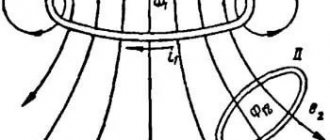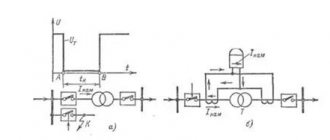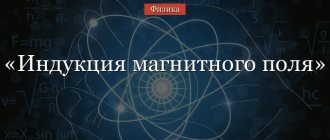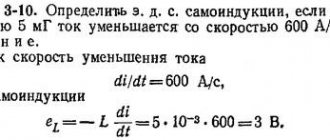The operation of all electrical machines is based on the phenomenon of electromagnetic induction. Sometimes it is difficult to imagine how such machines are able to work. For example, a transformer converts electrical energy of one value into another, while its windings are not connected to each other, actually through the air.
Asynchronous motors, their operating principle also explains the phenomenon of electromagnetic induction. What power does a rotating rotor have, what mechanisms can it drive? Let me remind you that the rotor is also not connected to anything; it rotates freely on bearings around its axis. But where does this power come from? Let's dig deeper and take a closer look at the phenomenon of electromagnetic induction.
The phenomenon of electromagnetic induction
When the current changes, a magnetic field is formed. This phenomenon, in turn, affects the movement of electrons.
If we consider a single wire located straight, it will create a field, the direction of the lines of force of which goes in a circle in a plane perpendicular to it.
If changes occur in the magnetic field, this increases or decreases the strength of the current that passes through the conductor. The direction of change depends on how the field changes. This phenomenon allows you to convert electrical energy into mechanical energy or vice versa.
The scientist credited with discovering the interaction of electric and magnetic fields is Michael Faraday.
Experiments were carried out that showed that a change in the magnetic field can generate the movement of electrons. This phenomenon was later called induced current.
The experiments performed by this scientist are as follows:
- Faraday made a coil with a hollow middle. Its ends were connected to a galvanometer. I picked up a magnet and placed it inside the coil. If you push it in or out, the needle on the galvanometer deflects, proving the presence of current. The faster the movement is performed, the greater its strength. A similar effect will be achieved if the magnet is stationary, but the solenoid moves.
- In the following experiment two coils were used. The big one is connected to the galvanometer, and the second one is connected to the source. One of the coils was so narrow that it could fit inside the second. If you place it there and turn the current on and off several times, the needle on the galvanometer will deflect, indicating the presence of current.
- If you take two solenoids under current and move one of them next to the other, then electron movement will also occur in them.
In such experiments, faster movement creates stronger electron movement.
Joseph Henry carried out similar research simultaneously with Faraday, but published his results later.
Explanation of the phenomenon
The movement of charge carriers - electrons - occurs when they are acted upon by an electromotive force created by a potential difference.
The emergence of a current under the influence of a change in the magnetic field occurs due to the fact that it creates a force called induced emf. Although the phenomenon of inductance was discovered by Faraday, he did not give it a theoretical explanation.
The electromagnetic field theory in physics was created by Maxwell in 1861. This phenomenon has the following features:
- the source of electron motion is an alternating magnetic field;
- its presence can be detected by the effect it produces on electrical charges;
- this field is not potential;
- field lines are closed curves.
The work of a magnetic field is expressed in the creation of an electromotive force for electrons.
Vortex electric field
A magnetic field varying in time and space is the source of the appearance of a vortex electric field with closed lines of force. Its effect explains the ordered movement of unit charges in a conductor in a (static) stationary state.
The direction of the electric field lines obeys the Lenz rule and the “gimlet” rule.
Vortex lines of force
Faraday's law of electromagnetic induction
The main characteristic of a magnetic field is magnetic flux. Visually, it can be represented as lines of force penetrating a perpendicular flat figure bounded by a closed line. These lines express the magnetic induction vector.
The product of the modulus of this quantity and the area for a uniform and homogeneous magnetic field is equal to the field flux through the circuit in question.
When considering a complex field, the figure is divided into small sections in which the field is uniform and the values for each of them are summed up. To calculate in such cases, methods of differential and integral calculus are used.
Electromagnetic induction is measured in Tesla (T). This unit got its name in honor of the great physicist.
Faraday's law
quantitatively describes the effect of a magnetic field on the movement of electrons.
He states the following: the rate of change of the flow of the electromagnetic field is equal to the electromotive force generated by it, acting on the electrons and creating a current.
It should be noted that when a magnetic field is generated by a change in current strength, the resulting electromotive force affects it in the opposite way. This can be made clear with this example.
If a wire is considered and the current in it increases, then this creates a magnetic field. This, in turn, creates an EMF, which prevents the increase.
Electromagnets in everyday life
Electromagnets are often used to store information, as many materials are capable of absorbing a magnetic field, which can then be read to retrieve information. They find application in almost any modern device.
Where are electromagnets used? In everyday life, they are used in a number of household appliances. One of the useful characteristics of an electromagnet is the ability to change its magnetic force by changing the strength and direction of the current flowing through the coils or windings around it. Speakers, loudspeakers and tape recorders are devices that implement this effect. Some electromagnets can be very strong, and their strength can be adjusted.
Where are electromagnets used in life? The simplest examples are doorbells and electromagnetic locks. An electromagnetic lock is used for the door, creating a strong field. As long as current passes through the electromagnet, the door remains closed. Televisions, computers, cars, elevators and photocopiers are where electromagnets are used, to name a few.
Lenz's rule
This rule makes it possible to correctly determine the direction of the induction current in various situations. It is formulated as follows: the direction of the current generated by induction creates such a change in the magnetic flux that prevents the change in the external field due to which it arose.
This can be illustrated with the following example. A situation will be considered when the external magnetic field increases over time, and its field lines are directed upward.
This will happen, for example, in a situation where a magnet is brought closer to a horizontal contour from below so that its north pole faces upward. In this case, the magnetic flux will increase, creating an electromotive force.
An induced current will be created in the circuit. It will be such that the magnetic lines of force are opposite to those that characterize the original. Now you can determine the direction of the induced current in the circuit.
As you know, if you look from the side of the created field, it will be directed clockwise. That is, if you look from above, the direction will be against it.
In this example you can see how using Lenz's rule you can determine the direction of the magnetic field and induced current.
What is an electromagnet?
An electromagnet can be considered as a temporary magnet that functions with the flow of electricity and its polarity can be easily changed by changing the direction of the current. Also, the strength of an electromagnet can be changed by changing the amount of current flowing through it.
The scope of application of electromagnetism is unusually wide. For example, magnetic switches are preferred because they are less susceptible to temperature changes and are able to maintain rated current without nuisance tripping.
Self-induction
In this case, we consider a situation where a change in the movement of electrons generates an EMF, causing an induced current in the same conductor.
Taking Lenz's rule as a basis, it can be argued that it has the direction opposite to the initial change.
Self-induction is similar to the phenomenon of inertia. A heavy body cannot be stopped instantly. It is also impossible to change the current strength in one moment to the desired value due to the presence of the phenomenon of self-induction.
This property can be demonstrated by the following experiment. You need to make two electrical circuits. One of them contains a source and a light bulb. The other is made in a similar way, but the difference is that a coil is added to the circuit.
In the first circuit, after switching on, the light comes on immediately. In the second, given the presence of an inductive element, this happens with a noticeable delay.
After opening, the light in the first bulb turns off almost instantly, while in the second it turns off slowly. It is important to note that during the shutdown process the induced current may exceed the initial one. Since in this situation it is directed in the same way as the worker, the current strength may increase. In some circuits this can cause the light bulb to burn out.
A language in which time flows from east to west
Berkeley scientist Alice Gaby and Stanford linguist Lera Boroditsky studied the Kuuk Taayorre spoken by the Australian Pormpuraau people of Queensland. Just like representatives of the Guugu Yimithirr, speakers of the Kuuk Tayorre language are oriented along the north, south, west and east, but Boroditskaya and Gebi also found that representatives of this tribe interpret time in a completely special way: in their language it is located along the east-west axis , with the past located in the east.
During several experiments, scientists gave tribe members a series of cards on which were drawn either a banana being gradually eaten, or a growing crocodile, or a gradually aging person at different ages. During the experiment, Kuuk Taayorre speakers first sat facing north, then facing south. But no matter how these people sat, they always laid out the drawings from east to west - in the same direction in which the sun moves across the sky during the day. Native English speakers who also participated in the experiment invariably laid out the cards in the same direction in which we read - from left to right.
So the researchers found that among native speakers of the Kuuk Taayorre language, the passage of time is closely connected with the cardinal directions. Lera Boroditskaya notes:
We didn't tell any of them which direction they were facing. But speakers of the Kuuk Taayorre language already knew this and spontaneously used the cardinal directions to express their ideas about time.
Inductance
A conductor through which a changing current passes is capable of storing energy through the use of a magnetic field. For a straight piece of wire this ability is insignificant.
However, if we are talking about a coil, then its magnitude is much stronger. This characteristic is called inductance. It is designated as “L” and plays an important role in determining various characteristics of the electromagnetic field.
The magnetic flux in a certain circuit can be expressed using the formula Ф = L* I, and the electromotive force in the form E = L* (dI/dt).
The current passing through the circuit is capable of creating an electromagnetic field, and it will be stronger the faster its changes occur.
In practice, to increase the inductance of the coil, ferromagnetic rods inserted inside are used.
Magnetic field energy
Electric current creates a magnetic field. In doing so, he expends a certain amount of energy. Its value is equal to the work that was spent on creating the field. It is calculated using the following formula:
The following notations were used here:
- W – magnetic field energy;
- L – inductance;
- I – current strength.
If the magnetic field disappears for some reason, its energy will be released in one form or another.
Electromagnets and their applications
Here are some of the examples where they are used:
- Motors and generators. Thanks to electromagnets, it has become possible to produce electric motors and generators that operate on the principle of electromagnetic induction. This phenomenon was discovered by scientist Michael Faraday. He proved that electric current creates a magnetic field. The generator uses the external force of wind, moving water or steam to rotate a shaft, which causes a set of magnets to move around a coiled wire to create an electric current. Thus, electromagnets convert other types of energy into electrical energy.
- Industrial use practice. Only materials made from iron, nickel, cobalt or their alloys, as well as some natural minerals, react to a magnetic field. Where are electromagnets used? One of the areas of practical application is metal sorting. Since the mentioned elements are used in production, iron-containing alloys are effectively sorted using an electromagnet.
- Where are electromagnets used? They can also be used to lift and move massive objects, such as cars before disposal. They are also used in transportation. Trains in Asia and Europe use electromagnets to transport cars. This helps them move at phenomenal speeds.
Application of electromagnetic induction
This phenomenon is actively used in various spheres of human society.
Below are some of the most famous examples:
- radio broadcasting is impossible without using the phenomenon of electromagnetic induction;
- in medicine, magnetic therapy is one of the effective treatment methods;
- in fundamental research, synchrophasotrons are used to accelerate elementary particles, the operation of which is based on the phenomenon of inductance;
- electricity meters used in everyday life to account for electricity use the phenomenon under consideration;
- in order to transmit electrical energy produced by power plants over long distances, transformers are used, the operation of which is based on the use of electromagnetic induction;
- In metallurgy, induction furnaces are used to melt metal.
The use of this phenomenon is very widespread. The examples given are just a sampling of the various use cases.
Magnetic field in medicine
Magnetic fields are widely used in medicine. There is also a special term – magnetic therapy.
Magnetotherapy is a method of physiotherapy, which is based on the effect on the body of magnetic fields of various parameters.
For therapeutic and prophylactic purposes the following are used:
- constant magnetic field (permanent magnetotherapy);
- pulsed magnetic field (pulse magnetotherapy);
- alternating magnetic field (low-frequency magnetic therapy).
Permanent magnetic therapy
With constant magnetic therapy, the body is exposed to a constant magnetic field for therapeutic and prophylactic purposes. To obtain a constant magnetic field (PMF), permanent magnets from various materials and various designs are used, as well as electromagnets with or without ferromagnetic cores, in the windings of which a constant electric current flows. The induction of constant magnetic fields is often 30-60 mT.
Figure 28. Permanent magnetic therapy
Pulse magnetic therapy
This type of therapy is based on the use of low-frequency pulsed magnetic fields for therapeutic, prophylactic and rehabilitation purposes.
The active factor in this method is eddy electric fields (currents) induced in the tissues by a powerful pulse
magnetic field. Inductive electrical currents can excite peripheral nerve fibers. As a result, afferent impulses from the pain site are blocked. Due to the excitation of thick myelinated fibers, contraction of the muscles innervated by them is also observed. In addition, this field, by inducing pulsed currents, causes rhythmic contraction of myofibrils of skeletal muscles, smooth muscles of blood vessels and internal organs.
Figure 29. Pulsed magnetic therapy
Low frequency magnetic therapy
The most common type of magnetic therapy is low-frequency, in which low-frequency magnetic fields are used for therapeutic, prophylactic and rehabilitation purposes. The action is based on the same mechanisms and physical and chemical effects as when using constant magnetic fields. However, the main operating factor is the formation of induced electrical currents in tissues, the density of which is determined by the rate of change of magnetic induction.
Minimal effects are observed at current densities of 1-10 mA/m. Such currents are induced in tissues when exposed to alternating MFs with an induction of 0.5-5 mT at a frequency of 50 Hz or 10-100 mT at a frequency of 2.5 Hz. More significant shifts are observed at an induced current density of 10-100 mA/m, which is induced when tissue is exposed to an alternating MF with an induction of 5-50 mT at a frequency of 50 Hz or 100-1000 mT at a frequency of 2.5 Hz.
Figure 30. Low frequency magnetic therapy
All formulas on the topic “Electromagnetic induction”
In order to briefly refresh your memory of the formulas related to magnetic induction, the following is a list of the most important of them.
The discovery of the laws that describe the behavior of the electromagnetic field is one of the most important scientific achievements in history. In modern life, the use of this phenomenon occurs in almost all areas of society.











